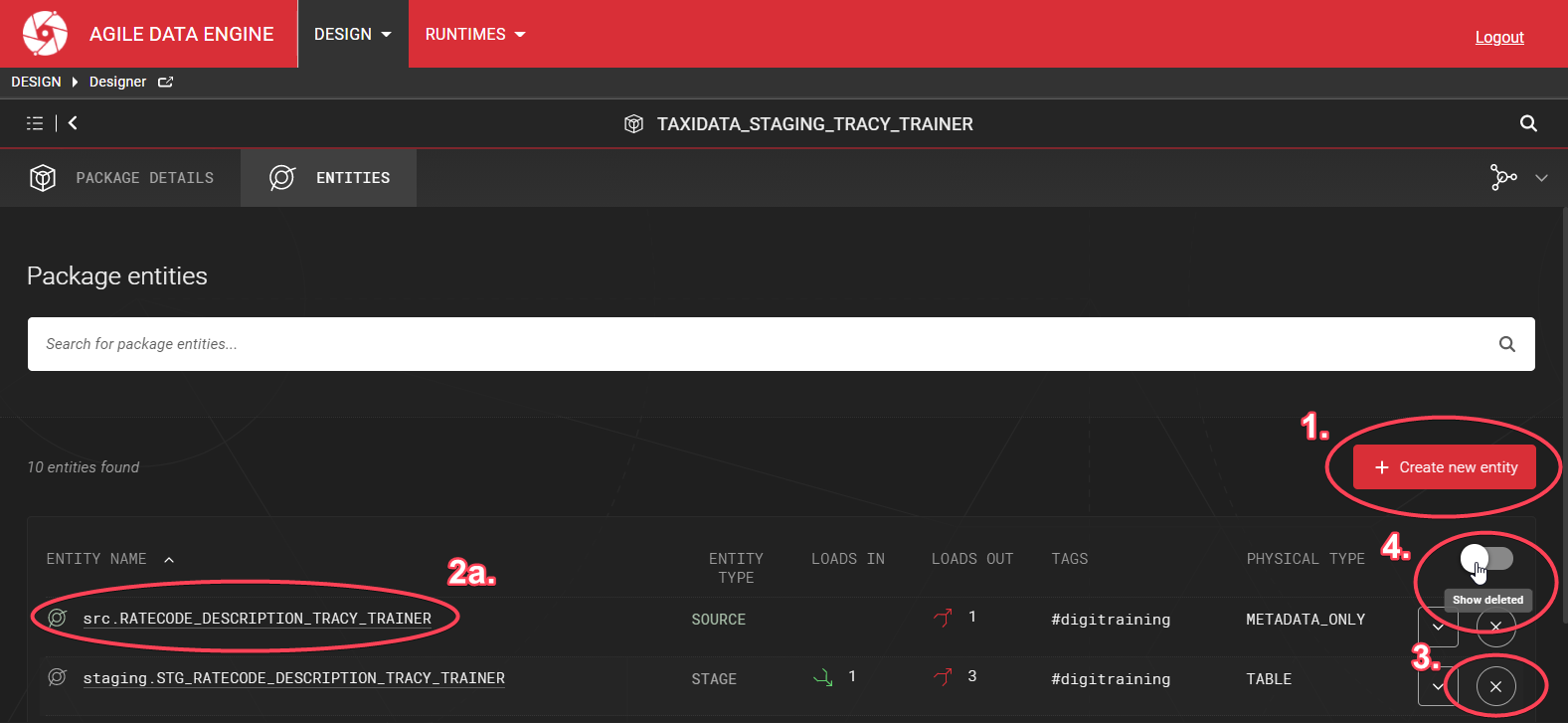Entities
Entity is a core metadata object in Agile Data Engine. An entity refers to data warehouse tables, views, materialized views, or informational metadata only objects (sources).
Building a data warehouse in Agile Data Engine is based on entities:
A data model is created by creating entities.
A data pipeline is created between the source entities and the target entities.
Each entity has metadata that provides information about the entity itself. The metadata of an entity can include:
Properties (see below)
Physical definitions
Test definitions
Tutorials
See the below videos for quick tutorials on how to create entities.
https://youtu.be/bV7n2nMntCchttps://youtu.be/EJUz_xuhpNwManaging entities
In the Entities tab you can:
Create a new entity.
Edit entities by selecting an entity in the Package entities view.
Soft delete entities.
View soft deleded entities by toggling the slider.


5. Restore soft deleted entities when Show deleted is toggled.

Entity properties
Property | Description |
|---|---|
ENTITY ID | Entity unique identifier |
ENTITY NAME | Entity full name including prefixes and/or suffixes configured for ENTITY TYPE in CONFIG_ENTITY_DEFAULTS. |
ENTITY LOGICAL NAME | Entity logical name. Logical name does not contain prefixes and/or suffixes (e.g. "H_" for HUBS, "F_" for FACTS...) configured in CONFIG_ENTITY_DEFAULTS. |
ENTITY TYPE | Default supported values: SOURCE, STAGE, HUB, SAT, SAT_C*, S_SAT, S_SAT_C*, LINK, PIT, BRIDGE, REF, DIM, FACT, FLAT, LOGICAL, GENERIC. |
MODIFIED | Timestamp and user name of last modification to the entity |
DW ZONE | Data warehouse zone/layer. Default supported values: NONE, SOURCE, INGESTION, RAW, BUSINESS_RULES, INFORMATION_DELIVERY, LOGICAL_MODEL. |
PHYSICAL TYPE | See Physical types |
DISTRIBUTION STYLE | |
SCHEMA | Database schema name |
FORCE RECREATION | With FORCE RECREATION: true, an entity is always recreated when deploying the package into the target database. Recreation of an entity is sometimes necessary to get all changes deployed. For example, changing the attribute order might require FORCE RECREATION: true to actualize in the target database. |
DESCRIPTION | Entity description/comment which is also written into the target database. |
* Automated entity types (default configuration), e.g. satellite current view (SAT_C) created automatically for satellite (SAT).
Deleting an entity
When you delete an entity:
The entity is soft-deleted, meaning it is not permanently removed and can still be recovered or viewed if needed.
Entity loads including entity mappings are permanently deleted.
Soft-deleted entities are visible by enabling the Show deleted toggle in the entity list.
After deleting an entity:
Commit and deploy the deletion to all Runtime environments where the entity was previously deployed.
This ensures:
The ADE metadata reflects the deletion accurately.
The target database schema is kept in sync with the entity model.
Neglecting to deploy the deletion may lead to mismatches between design-time and runtime, potentially causing errors or inconsistencies.
ADE does not drop entities from the target database when deploying an entity deletion, instead ADE renames the entity with Z_<entity_id>_BACKUP_<n>, for example:Z_72C59F90_0B6D_47AC_AA6B_A484CCA7B85D_BACKUP_43087.
